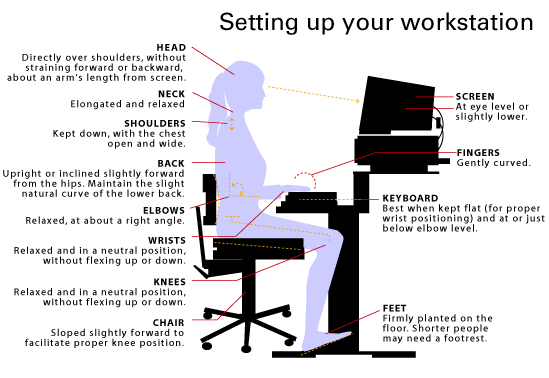DOES YOUR JOB CAUSE YOUR PAIN?

In today’s world, many jobs, careers, and workplaces, create stress on your body either on the wrists, elbows, shoulders, neck, or back. People in occupations that involve force, improper posture, and repetitive use of certain body parts are at risk of constant pain. Every day people who work at jobs that require them to sit for long hours, stand for prolonged periods of time, push and pull, bend, lift, and twist are at risk, as these are just some of the movements and positions that take their toll on your body. The worker is using his or her muscles, but in a very specific and sometimes unnatural way to do the job. The stress these movements create on the body’s muscles and tendons can cause tightness and soreness, which in turn can result in painful trigger points. Trigger points can eventually lead to more serious symptoms such as repetitive strain injuries, decreased mobility, and even loss of function.
Here are 4 simple tips on how to avoid these symptoms and workplace related pain:
1. Setting Up Your Workstation.

When you arrive for work or sit down in front of a computer, take time to adjust your workstation. All equipment should be adjusted to fit your body comfortably for the entire work day. Developing a habit of correct preparation at the workstation can save hours of inefficient and unproductive time because of musculoskeletal discomfort and pain.
2. What to Avoid.

- Avoid reaching behind you and twisting your spine backward.
- Avoid overreaching.
- Limit frequent, fast, and forceful movements.
- Be sure there are no obstructions in your work area.
- Avoid too much load beyond your capacity.
3. The Importance of Good Posture.

Correct posture allows for increased blood flow throughout the body and reduces harmful compression of the spine. Good posture at your workstation for such as those who work at a desk on a computer starts with sitting up straight with proper support along the curve of your spine, keep your feet flat on the floor, and your knees bent at a 90 angle. You can discuss good posture at your specific workstation in more detail by seeking a medical professionals opinion.
4. Take Rest Breaks.

A lack of fresh air, poor or too much lighting, too much noise, and cramped quarters all make your workday more difficult and takes a significant toll on your body. Remember to take breaks and get outside, (regardless of the weather), if only for a few minutes during your lunch. Some workplaces provide ergonomically safe and well-designed equipment in your workspace, but even if you have that, you may still have the same physical aches and pains as you did before- if you don’t take adequate REST BREAKS. In an eight-hour workday, you need cycles of work and rest to stay productive and healthy. To avoid strain and tension in your muscles, its necessary to stop and take several rest breaks throughout the day. Even if you are in a rush to complete a task, it is crucial to pause in your work periodically. You don’t save time by skipping breaks. The fatigue you feel will affect your productivity and without breaks you increase the risks of musculoskeletal injury.
What You Should Do On Your Rest Breaks.
Spend your rest breaks correcting posture and going over some body alignment techniques. – (Consult a medical professional for body alignment techniques)
Stretch those muscles.
Use your lunch period to prepare your body to work the second half of your day. Get up and move! Walk around the hallway and go outside for some fresh air.



Besides using your equipment safely, you must remember to stretch throughout the day. Do general stretching, such as reaching for the sky, and touching your toes. These sorts of stretches limber up and loosen tight back muscles that can cause serious pain. The tighter your muscles are, the more chance of pain and injury. Remember, total body stretching in the morning, before work, prepares your body for your daily tasks.
Last, but not the least, make sure to get REGULAR EXERCISE.

A regular exercise regimen prescribed by a medical professional, regular visits for physiotherapy and chiropractic care, will help you to help maintain flexibility and mobility and to restore and maintain normal muscular functions.
Make sure to call us today to book an appointment to come in to iWellness.ca Rehab & Wellness Clinic for more exercises, treatments, and other information on what you can do to avoid work pain and keep working safe and healthy for the long haul.





















